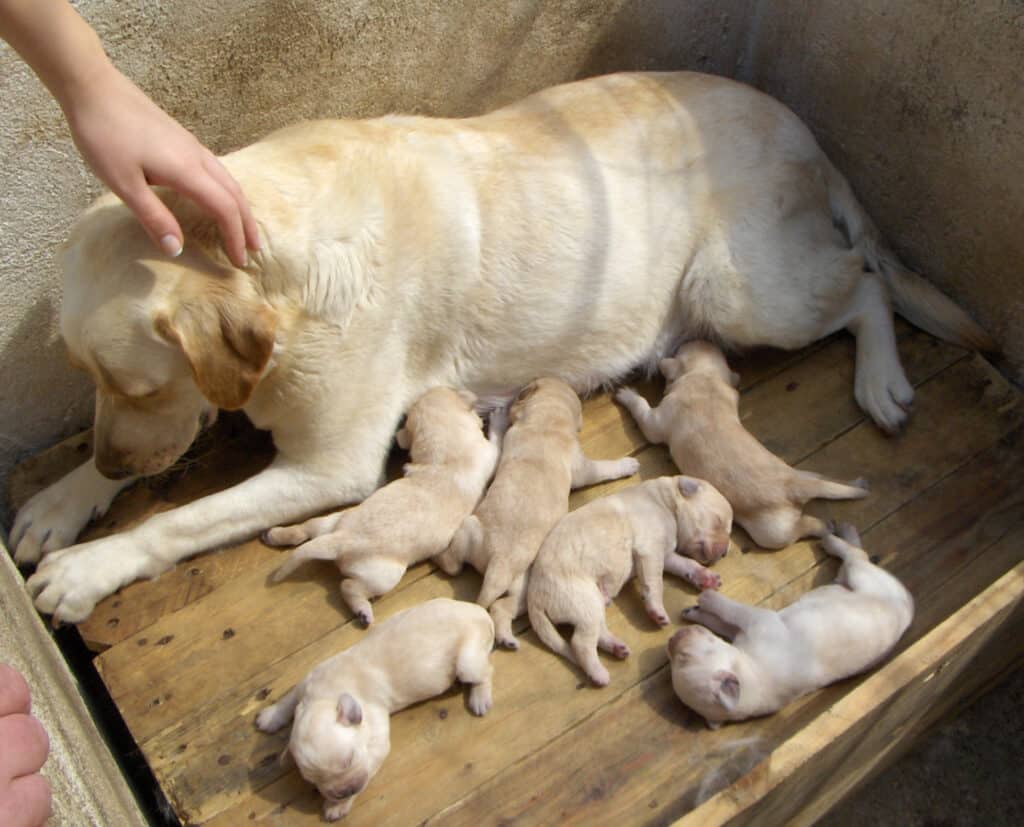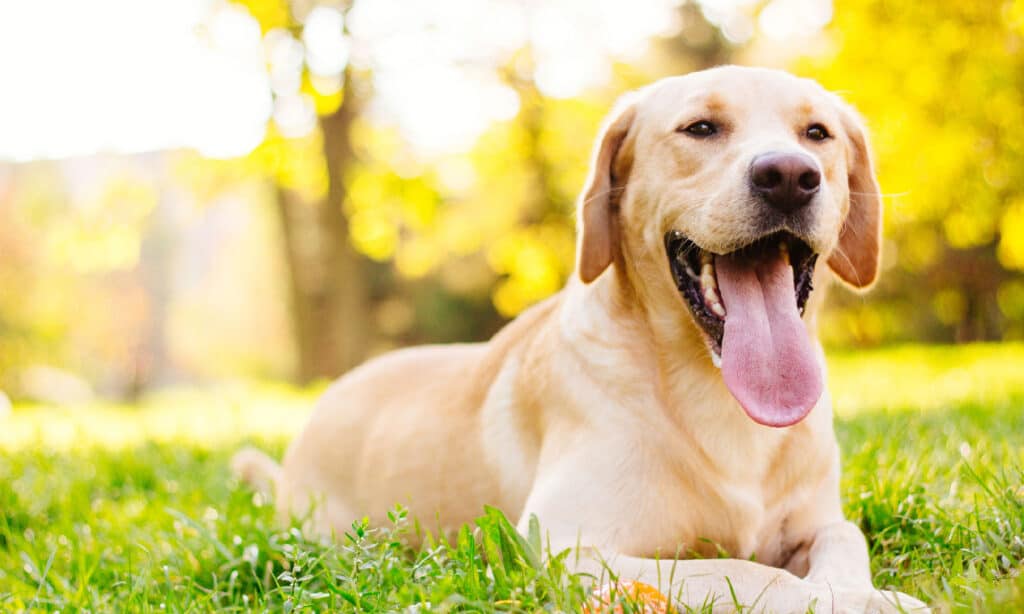Labrador retrievers are friendly and playful, which makes them excellent family dogs. Expecting Lab puppies can be an exciting time, but it can also be overwhelming. Pregnant dogs need special care and attention. This guide focuses on what to expect during a Labrador retriever pregnancy. With the right care, you can help your pregnant Labrador retriever stay healthy and comfortable. With a healthy and happy mother, you can welcome a perfect litter of Labrador retriever puppies into the world!
This complete guide covers Labrador retriever pregnancy, including symptoms, timeframes, and care instructions. It also covers the average litter size and what to expect each week during the pregnancy. Finally, this guide covers how to prepare for a Labrador retriever’s labor and delivery, as well as how to care for the new mom afterward.

A Labrador retriever can give birth to puppies of any color.
©iStock.com/Suzana Dreno
Labrador Retriever Summary
Labrador retrievers were bred as hunting dogs. The name “retriever” refers to their job, which was to retrieve the game that a hunter shoots. Labrador is the name of a region in Newfoundland. Fishing dogs were brought back to England from the Newfoundland Colony and bred to become Labrador retrievers. Today, these dogs are a popular breed around the world. They are excellent family and companion dogs.

Labrador retrievers are energetic, friendly, and easy to train.
©iStock.com/sanjagrujic
Labrador Retriever Pregnancy Symptoms
Pregnancy symptoms in dogs can be subtle. One of the best ways to know if your Labrador retriever is pregnant is to be aware if she has recently been in heat. This is the period in which a dog can become pregnant. Dogs typically go into heat twice a year. When a dog is in heat, she may show a range of signs. The first of these is swollen genitalia and red discharge. She may also lick her backside more. Another sign is urinating more frequently. Lastly, her social behavior may change. She may become more friendly with other dogs and try to approach male dogs.
If your Labrador retriever has recently been in heat, you can start to keep your eye out for early pregnancy symptoms. The first signs of pregnancy that may present are appetite loss and lethargy. Later signs of pregnancy are a firm abdomen and the ability to feel puppies inside when touching the dog’s abdomen. It is important to let a trained vet feel a dog’s abdomen because it can hurt the puppies if done incorrectly. In late pregnancy, a dog may have an increased appetite, and her nipples will get larger.
Gestation Period: How Long Are Labrador Retrievers Pregnant?
All dog breeds are pregnant for around 63 days. This means a dog’s pregnancy only lasts about two months. It can be easy to miss the early signs of pregnancy in dogs, so it is important to pay close attention after a dog is in heat.
Pregnancy Care for Labrador Retrievers
Once you know or suspect your Labrador retriever is pregnant, you can take steps to keep her healthy and comfortable. The first step is to feed her nutritious and high-quality dog food. If your dog is already eating a nutritious diet and at a healthy weight, you may not have to change anything early in the pregnancy. You can confirm this by asking a trained vet. If you suspect your Labrador retriever is pregnant, it is important to schedule a visit to the vet. A trained vet will let you know if you need to make any changes to your dog’s diet early in her pregnancy. During a dog’s third trimester, as the fetuses are growing rapidly, your vet may recommend switching to a food that is formulated for pregnant dogs.
Another important way to care for a pregnant Labrador retriever is to make sure she gets the right kind and amount of exercise. Avoiding strenuous exercise in the first two weeks of a possible pregnancy may help the embryos implant. This is something to consider if you are trying to breed your dog. After the first two weeks, normal exercise is recommended until the final trimester of pregnancy. During the final trimester, it is best to limit strenuous exercise. A good way to keep your dog healthy during the final trimester is to go on shorter walks throughout the day.
Finally, a pregnant Labrador retriever needs to visit a vet. If you are trying to breed your lab, getting a prenatal checkup can help make sure she is healthy enough to carry puppies. She needs to be current on vaccinations and free of parasites. Your vet may recommend parasite treatment to be sure your dog is parasite-free. Once your dog is pregnant, regular vet visits can make sure she stays healthy. A vet can let you know if your dog is able to have a natural birth, or if she may need a cesarean.
Average Litter Size for Labrador Retrievers
The average litter of puppies for any dog breed is five to six puppies. A typical Labrador retriever litter is a bit larger. A 2011 study found that Labrador retrievers had between one to 13 puppies in a litter, with an average litter size of seven puppies. An x-ray can confirm the number of puppies in your dog’s litter beginning in week eight.

An x-ray can confirm how many puppies are in your Labrador retriever’s litter.
©Ground Picture/Shutterstock.com
Week 1
A dog typically does not show symptoms of pregnancy in the first two weeks. Week one is when mating occurs and when the female dog’s eggs are fertilized by the male dog’s sperm. It is a good idea to schedule a prenatal checkup before mating. During the first week, avoid making changes to her diet unless directed to by a trained vet.
Week 2
There are typically no symptoms in a dog’s second week of pregnancy. During this time, your dog should be maintaining her ideal healthy weight. Too much weight gain early in a dog’s pregnancy is a health risk. A vet can let you know what a healthy weight is for your dog.
Week 3
Week three is the earliest time that a vet can confirm a Labrador retriever pregnancy. The beginning of week three is typically when the embryos implant in the uterine lining. Starting in week three, a vet can do an ultrasound to confirm the pregnancy and check for any abnormalities. Alternatively, your vet may confirm a Labrador retriever’s pregnancy by a blood test. The vet may also be able to estimate how many puppies are in the litter, although early estimates may not be accurate.
Week 4
A vet may perform a pregnant dog’s first ultrasound in the third or fourth week of her pregnancy. If your dog does not have her first ultrasound in week three, she may have one in week four. While they can be helpful, an ultrasound may not be entirely necessary for a healthy pregnancy. You can decide with your vet if one is right for you and your Labrador retriever.
Week 5
Week five is the beginning of the fetal stage. At this stage, the developing puppies are now called fetuses instead of embryos. In week five, the fetuses begin to grow their internal organs. This is when the fetuses will start to rapidly gain weight. During weeks five and six, fetuses grow 75 percent larger by weight. You can expect your pregnant Labrador retriever to gain more weight starting in week five. A vet will let you know what a healthy amount of weight gain is for your dog based on her individual weight.
Week 6
Week six marks the third trimester of a Labrador retriever’s pregnancy. This is a good time to switch your dog’s diet to high-quality food formulated for pregnant dogs. In week six, the fetuses continue to develop internal organs and gain weight. Their skeletons begin to solidify, and their claws begin to grow.
Week 7
In week seven, the fetuses continue to grow. A milestone of week seven is that the fetuses begin to grow hair. At this time, your pregnant Labrador retriever may shed hair on her stomach. This is normal and not a cause for alarm. Week seven is an ideal time to start setting up an area for your Labrador retriever to give birth. This is called a whelping area. More information on how to choose and prepare this location is below, in the section on how to prepare for labor and delivery.
Week 8
In week eight, the puppies’ skeletons finish forming. At this time, a vet can perform an x-ray to confirm the litter size. This may or may not be necessary, and your vet will let you know if it is a good option for your dog or not. Starting in week eight, a dog can go into labor at any time. It is important to have an area set up for her to give birth by this point. A pregnant Labrador retriever may also start lactating at this time. Another way to help make her comfortable during week eight is to trim the hair around her nipples and backside to prepare for birth and nursing.
Week 9
Week nine is the final week of a Labrador retriever pregnancy. During this time, your dog may start to spend more time in her birthing area. She may also show some signs of anxiety. These signs can include panting, pacing, and loss of appetite. As labor approaches, it may be comforting to let your vet know so that they can be on standby in case of any concerns that may arise.
How to Prepare for Labor and Delivery
You can start preparing for a healthy labor and delivery when you first start to plan for or suspect a Labrador retriever pregnancy. This includes vet visits, proper diet, and proper exercise. However, as labor approaches, there are some extra important steps to take to prepare.
The most important way to prepare your Labrador retriever for comfortable labor and delivery is to set up a whelping area. For dogs, whelping means giving birth. A whelping area should be out of the way of foot traffic so that the mother can have privacy and peace. It should also be an area that you won’t need to use for a couple of weeks since the mother will remain there with her puppies after birth. This area needs to be warm and cozy. It is important to include a whelping box in this area. These boxes give the mother and puppies safety and comfort. If you do not plan on continuing to breed, a large cardboard box can make a good whelping box. If you want, you can buy a whelping box or make your own. The whelping box should be easy for the mother to get in and out of, but keep the puppies safely contained.
How to Care for Your Labrador Retriever Afterward
The postpartum period begins after your Labrador retriever has given birth. After she has finished giving birth, you may clean her with a warm, wet rag. Avoid soap as the newborn puppies may be sensitive to it. You may also provide clean bedding if the mother will allow it. Be sure to respect her space. You will also want to provide nutritious food and plenty of drinking water.
If you have any concerns about your Labrador retriever during or after whelping, contact your vet. After birth, look out for symptoms in the mother such as panting, muscle tremors, dilated pupils, or appetite loss. If you notice any of these signs, contact a trained vet. A vet can advise you in the event that your Labrador retriever needs extra care after whelping.
Ready to discover the top 10 cutest dog breeds in the entire world?
How about the fastest dogs, the largest dogs and those that are -- quite frankly -- just the kindest dogs on the planet? Each day, AZ Animals sends out lists just like this to our thousands of email subscribers. And the best part? It's FREE. Join today by entering your email below.
Thank you for reading! Have some feedback for us? Contact the AZ Animals editorial team.








